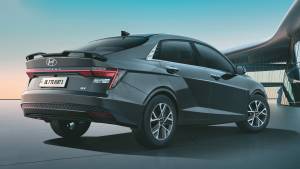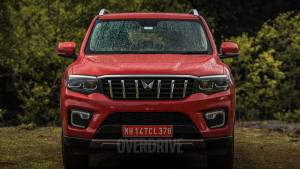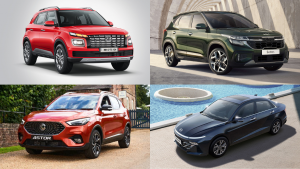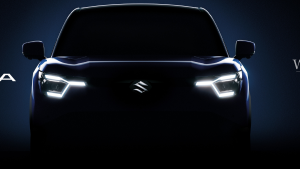Nissan Sunny vs Hyundai Verna vs Toyota Etios
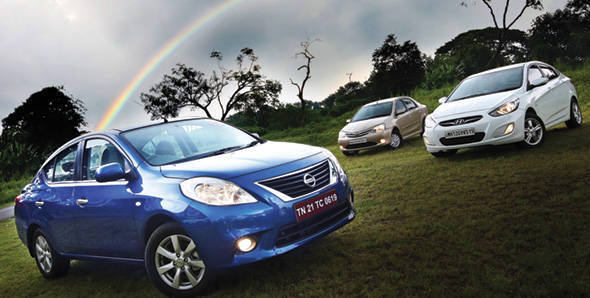
I remember when I drove the Nissan Sunny in India for the first time and came back to office. Apart from everyone going 'sunny side-up' ten thousand times, the joookes on the ad were wearing thin. So the banter shifted to guessing the price. Everyone put the car in the seven lakh plus category, considering the features it had. But when Nissan announced the price a week later, it was a shocking Rs 5.58 lakh for the base variant. This suddenly made the Sunny a very bright choice (pun intended) for those looking to move up the ladder. But was just the pricing good enough or did the Sunny need to be more? So we called over a few competitors - the Hyundai Verna 1.4 and the Toyota Etios to see if a caaaar made more sense than just a car.
STYLING
Beginning with the Sunny it doesn't have the lines to blow your mind, in fact from certain angles it does look a bit odd. At the front it feels like Nissan has tried to give the Sunny a Teana-like look with its sharp headlamps and huge boxy grille but this doesn't gel well with the rest of the car. There is a well-defined shoulder line that grows strong and prominent at the front and rear fenders, and then neatly merges into the bumpers. The forward half of the car is also Micra-ish but after the B-pillar, the roofline slopes down all the way to the boot giving the car a rather disproportionate look. From the rear however, the Nissan family design is evident giving it a baby-Teana look. What clearly identifies this car is its size, particularly its length. If placed in a parking lot besides the competition the Sunny will stick out by over a foot, like a Parsi stands out by virtue of their loooong noses.
Shifting to the Etios then. By now Toyota are probably rueing the missed opportunity - the opportunity to give the Etios a smattering of style considering it was designed from the ground up for the Indian audience. What we have is reminiscent of the boxy Logan from certain angles and won't draw a second glance. The nose sports the typically smiling Toyota grille (cheesily called smile-line) but the rest of the car looks very plain. The simple three-box design makes it look more like an old school sedan but unlike the Sunny the dimensions look more proportionate.
The Verna is by far the best looking car here. The new fluidic design philosophy-inspired Hyundais are simply gorgeous to look at and the Verna is one of the finest. The Verna looks like it's in motion at standstill and has sharp creases giving the car a futuristic look that's great to view from all angles. The front end is low and wide while the headlamps are sharply detailed for a sporty look accentuated by the coupe-like silhouette. In this test it is the Verna that will catch your attention and hold it long enough for the other cars to get bored and drive away. (Footnote: the 1.4 Verna doesn't get alloys, the ones pictured here are after-market items).
INTERIORS
Step inside the Sunny and you will be in familiar surroundings. The dashboard is similar to the Micra with the same steering wheel, door pads and door handles and retaining the same funky elements such as the circular climate control console, air con vents and steering controls. Fresh elements are the stereo face plate and central air con vents while the instrument console is also different and doesn't look quirky as in the Micra.
The grey and beige theme or 'greige' as termed by Nissan does little to enliven the cabin but it's not too dull either thanks to the contrasting brushed aluminium elements. The overall fit and finish is good and the quality of materials makes it feel relatively up market. The front seats are generous and offer good thigh support. The ace in the pack though is the rear quarters; with the wheelbase stretched out by 150mm over the already spacious Micra's, there's incredible space at the back. We measured the knee room and with an incredible 990mm, it turns out to be just 5mm lesser than a Skoda Superb. Now that's truly limo class! The floor is flat without any transmission tunnel intrusions and there is also a foldable central armrest with cup holders. Shoulder room is good but since the central perch is contoured the third passenger at the back won't be very comfortable unlike in the Etios.
Even more than the exteriors, the interiors of the Etios are dull and totally lacking in styling flair. Form and function take centre stage like the massive glove box or the stacked air-con vents which deliver better circulation of cool air. A racy touch is the flat-bottomed steering wheel that is also great to hold and the red inserts on the seats but otherwise this is a boring cabin. Quality of materials is good and despite solid abuse nothing has begun to rattle in our long term test car however the quality perception gets a beating when you touch the hard grey plastics.
The cabin however scores on comfort. The front seats might look flat but they are accommodating, comfortable and supportive over long drives while the rear seat does look like a flat bench but that very flatness, allied to more shoulder room, makes it more comfortable for three people than the Sunny. Rear knee room is not as generous as the Sunny (80mm short) but the Nissan honestly has way more than you'd require. The Etios is sufficiently spacious and is great for long drives as we experienced on our Golden Quadrilateral drive in the Etios a few months ago.
But if you want to feel good about yourself you need to be in the Verna. The dashboard has a textured look but the quality of materials is only average while the Civic-inspired steering wheel (also on the i20) looks sporty but doesn't feature stereo controls which the other two get. The blue backlight, like in most Hyundais, can be a bit too garish for some tastes but adds to the upmarket look. The beige-black dual tone colours along with lighter hued seats give it a sense of roominess and here too the transmission tunnel is absent but space at the back isn't as generous as the other two being 140mm and 60mm lesser than the Sunny and Etios. The rear seat has a low H-point so ingress and egress is also not that easy and shoulder room is tight for three. The front seats are ample but don't offer much support.
FEATURES
The Sunny is available in three variants and differ in spec. The basic XE variant gets regular air con and no climate control but driver airbag and ABS are standard. The XL additionally gets a front passenger airbag, integrated stereo, rear air blower and keyless entry. The top end XV features keyless ignition, alloy wheels and electric mirrors.
The Etios is available in five variants with the base model offering the bare minimum - air conditioning and power steering. The top VX variant we are driving gets ABS, twin front airbags, alloys, stereo and steering mounted audio controls. The Verna is known for its long list of features but the car we are driving here is the Verna 1.4 that is available in only one variant. It does get a fully-specced stereo that gets Bluetooth mobile phone connectivity and can play music from your Bluetooth phone, USB or iPod/iPhone (all unique in this test). But that's where it ends. There is no climate control, steering mounted audio controls, alloy wheels and it misses out on vital safety features such as ABS and airbags which we strongly feel should be offered especially since this is the most expensive car in this test.
POWERTRAIN
The Sunny gets an all-new four-cylinder twin-cam 1498cc engine codenamed HR15DE churning out 99PS of max power at 6000rpm and 134Nm of peak torque at 4000rpm. The petrol engine (no diesel as of now) is eager to rev but gets loud and whiny as the revs climb and is focused on efficiency rather than performance. The 5-speed transmission has a short throw but the shifts aren't slick and to harness performance from this engine you must work the gears.
Our previous reports did rate the Etios' engine as the benchmark in its segment and the Nissan doesn't trouble its reign at the top, despite the Toyota churning out only 90PS of power from 1496cc. This engine is a product of extensive research into Indian driving patterns and the key to that is the terrific torquiness. 132Nm of torque comes in at just 3000rpm translating into effortless city commuting and great driveability due to the solid bottom end. On the highway fifth gear is all you will need and even in the city fourth gear suffices for most part. But that's not to say it doesn't enjoy being revved, on the contrary it has a surprisingly sporty demeanour rushing to its rev limiter hungrily and also emitting a sporty exhaust note. Shift to a lower gear via the extremely slick gearbox and the engine is ready to play ball.
Hyundai are known for their smooth and refined petrol engines that are peppy and ideal for driving around in the city. The Verna is no exception, the 1396cc Gamma petrol engine is the smallest of the three but has the best figures - an impressive 107PS at a rather high 6300rpm and 135Nm of peak torque at 5000rpm. It is a sophisticated unit with variable valve timing on the intake side and allied to the gear ratios well tuned to torque spread, it makes for effortless city driving. The five-speed gearbox however lacks feel and isn't as slick as the Toyota's.
PERFORMANCE
On paper there's very little to separate the three. The Sunny with its short gearing launches well off the line to clock a 0-100kmph time of 12.77 seconds. That's just 0.21 second slower than the Etios and 0.38 second quicker than the Verna. The Sunny crosses the quarter mile in 18.65 seconds, again the Etios is ahead by 0.25 second while the Verna is just 0.18 second behind the Sunny. The transmission in the Verna has short initial gearing (typical to most Hyundais) but third gear onwards the ratios get taller and this not only aids in fuel efficiency but also in higher top speed, which in this case was recorded at 184.4kmph. The Sunny in comparison manages a decent 175kmph while the Etios maxes out at a close 174.6kmph.
In terms of fuel efficiency, the Sunny returns 11.9kmpl in the city while on the highway she returns an impressive 21.1kmpl resulting in an overall figure of 14.2kmpl. The Etios meanwhile returns 13.1kmpl in the city and 18.7kmpl on the highway, however the overall figure is higher at 14.5kmpl. But the leader here is the Verna, the smallest engine of the lot helps it deliver a respectable 12.8kmpl in the city while on the highway the car manages to return 20.4kmpl resulting in a winning overall figure of 14.7kmpl.
RIDE AND HANDLING
All three have the same suspension setups - MacPherson struts up front and a torsion beam at the rear - with more or less similar tuning for Indian conditions. This means a soft ride in the Sunny's case to soak up rough roads and the longer wheelbase also cures a lot of the Micra's soggy and bouncy road manners. There is a fair bit of body roll but its all par for the course in this class and on the highway she is planted and stable, capable of triple digit cruising speeds. The steering is light and makes manoeuvring through tight spaces and parking effortless while on the highway the steering gains weight and feels confident.
However it is the Toyota Etios in India that wins this round with a great balance between ride and handling. Out of the three the Etios is the driver's car, it feels secure and will bring a smile on the enthusiast's face. The steering is light and easy for city work but has good precision and decent feedback to allow a bit of corner carving. There is body roll but the front end has good bite and resists understeer better than the other two, the tactile feel of the steering wheel, lovely gearbox and responsive engine all making it an enjoyable drive.
The ride quality is also quite good and though it errs on the softer side, it is a setup that works over all kinds of Indian roads making for effortless long distance commuting.
The Verna too is good at isolating rough patches and provides very good ride quality even on bad surfaces. But this is at low speeds. As speed builds the Verna's soft suspension is unable to retain composure and gets all rattled by uneven roads and bumps. The nose bounces, the rear suspension bottoms out and passengers are in for an uncomfortable ride. Drivers will not enjoy the overservoed steering that lacks feel and hampers confidence at speed particularly since it has a quick steering ratio.
Since the Hyundai "Fluidic" Verna 1.4 in India has no ABS the car takes a whole 13 metres more to come to a halt from 100kmph to standstill (57 metres in four seconds) when compared to the ABS-equipped Etios and 10 metres more than the Sunny that also comes equipped with ABS.
VERDICT
The Verna is by far the best looking car (inside and out) of the three and also looks and feels more premium, like it belongs to a class above. It also offers the best ride though that compromises stability at speed. Which we can overlook to an extent, harder to ignore is you can't get essential safety equipment like ABS and airbags, particularly at the Hyundai "Fluidic" Verna price in India of Rs 7.33 lakh, ex-Delhi price.
The Sunny impresses with its space and features, the car is shockingly spacious at the rear. But we would have liked to see the same amount of excess elsewhere in the car, perhaps a punchier engine or better dynamics or less quirky and more conventionally good looking lines. The space may be a good thing if you're chauffeur driven and starting at Rs 5.78 lakh fleet operators, we are sure, will gobble up every dealer's stock of white Sunnys.
However the Etios doesn't lack in space, in fact with a wider and flatter rear bench it is a wee bit more comfortable for three. Then there's the stronger engine, better performance and efficiency, better ride and handling balance, a rock solid reputation for reliability and a far stronger dealer network. And to top it all the Etios is better value with the Toyota Etios price in India of Rs 6.82 lakh for the top end VX compared to the Nissan Sunny price in India of Rs 7.68 lakh, ex-Delhi.
Starts Rs 7.05 Lakhs
1498cc
Automatic
86
134
17.50 Kmpl
Starts Rs 9.31 Lakhs
1493cc
Automatic
115
250
-NA-
Starts Rs 31.99 Lakhs
1984cc
Automatic
190
320
15.10 Kmpl
Related Stories
Top Stories
Latest Videos
Most Popular
Network18 Updates

